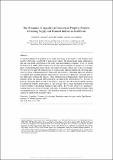The Dynamics of Liquidity in Commercial Property Markets: Revisiting Supply and Demand Indexes in Real Estate
Author(s)
Dijk, Dorinth W. van; Geltner, David M.
DownloadAccepted version (290.1Kb)
Open Access Policy
Open Access Policy
Creative Commons Attribution-Noncommercial-Share Alike
Terms of use
Metadata
Show full item recordAbstract
A common definition of liquidity in real estate investment is the ability to sell property assets quickly at full value, as reflected by transaction volume. The present paper makes methodological and conceptual contributions in the study and understanding of liquidity. First, we extend the Fisher et al. (Real Estate Economics, 31(2), 269–303, 2003) Fisher et al. (The Journal of Real Estate Finance and Economics, 34(1), 5–33, 2007) methodology for the separate tracking of changes in reservation prices on the demand (potential buyers) and supply (potential sellers) sides of the asset market. We show how to apply the methodology to a repeat sales indexing framework, allowing application to typical commercial property transaction price datasets, which lack appraisal valuations or complete data regarding property characteristics. We also use a Bayesian, structural time series approach to estimate the indexes. These methodological enhancements enable much more granular supply and demand index estimation, including at the metropolitan level. Second, we propose a Liquidity Metric based on the indexes, and show that the normal liquidity dynamic in commercial property asset markets is “pro-cyclical”, that is, price and trading volume tend to move together, with demand tending to lead supply. Additionally, we observe an “anomalous” dynamic that occurs about 25 percent of the time, in which the Liquidity Metric declines while consummated prices are rising. This anomalous dynamic is often associated with the end of a period of rapid price growth.
Date issued
2020-07Department
Massachusetts Institute of Technology. Center for Real EstateJournal
Journal of Real Estate Finance and Economics
Publisher
Springer Science and Business Media LLC
Citation
Dijk, Dorinth W. Van, David M. Geltnera and Alex M. van de Minne. “The Dynamics of Liquidity in Commercial Property Markets: Revisiting Supply and Demand Indexes in Real Estate.” Journal of Real Estate Finance and Economics, 583 (July 2020) © 2020 The Author(s)
Version: Author's final manuscript
ISSN
0895-5638